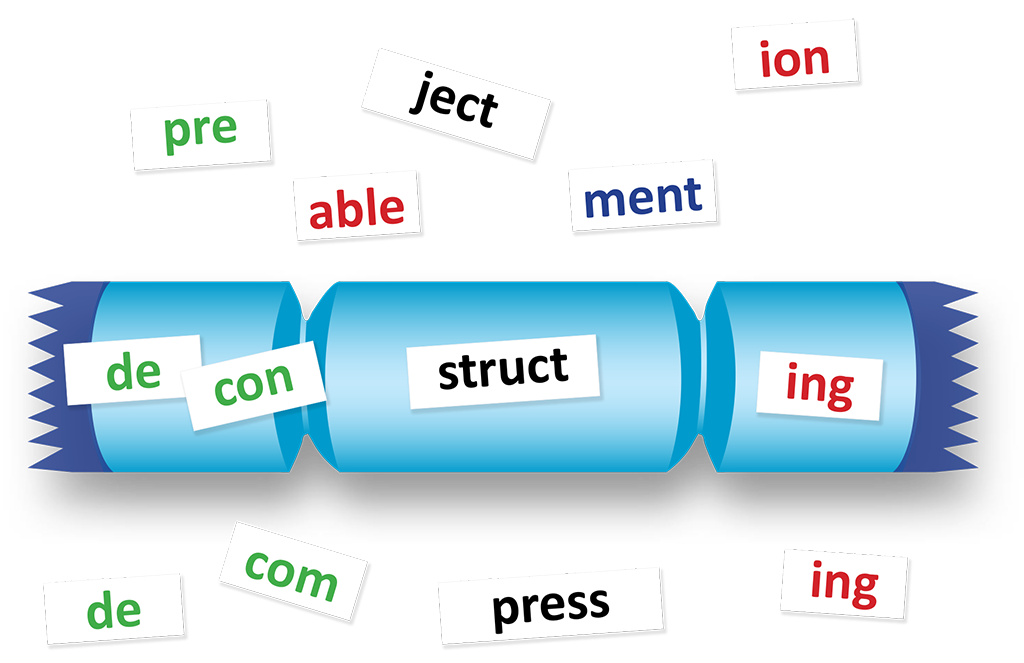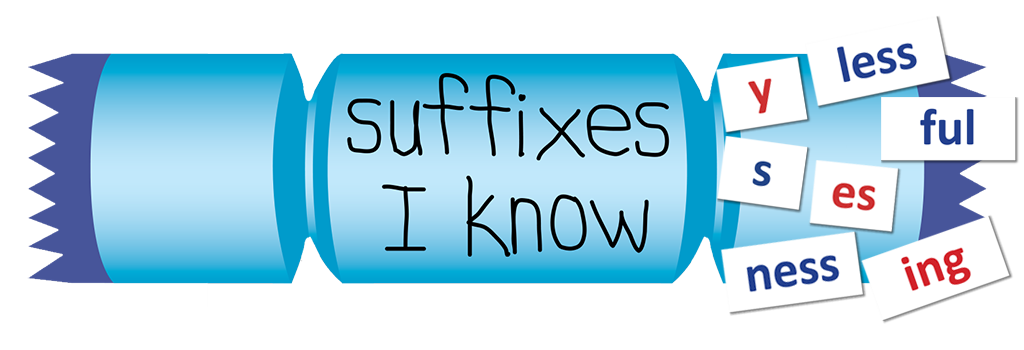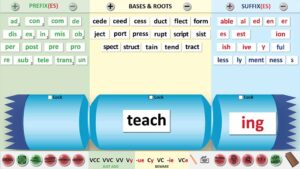Word Cracking Morpholgy
A complete set of resources for teaching English morphology.
Use the Word Cracker to teach and review morphology and grammar concepts with entire class groups, small groups and individual students.
The Word Cracker clearly illustrates how complex multisyllabic words are formed from simple parts (morphemes) – base words or roots and affixes.
As well as developing grammatical understanding, this process supercharges vocabulary development as students rapidly build their lexicon from known words to more morphologically complex derivatives of these words.

How the online Word Cracker works
The Word Cracking online morphology resources are designed for teachers, tutors and parents to follow step by step using the Word Cracking software, lesson plans and resources.
By subscribing to the resources, you gain access to all the content, the word cracker interactive tool, downloadable templates and membership of the supportive Word Cracking Facebook group.
The demo video goes through how to use the system step by step, and the Word Cracking team is always happy to answer your questions and support you in making the best use of the resources.
Designed for Intervention and Classroom Teaching

Although the Word Cracker was originally designed for Playberry™ intensive tier three intervention, we have written this resource with classroom teaching firmly in mind. Classroom Teachers with a basic grasp of morphology and suffixing spelling rules can use the Word Cracker to teach and review morphology and grammar concepts with entire class groups, with students working at tables or on the mat using their Individual Student Word Cracker Whiteboards.
Classroom teachers, of course, do not have to adhere to the Playberry™ teaching sequence. However, any quality structured synthetic phonics program will have a set teaching sequence that maximises student learning.
The Importance of Morphology to Reading and Spelling
Phonemic awareness is a finely tuned sensitivity to how words come apart into their smallest units of sound (phonemes). Synthetic phonics teaches how graphemes (units of spelling) represent these sounds in writing. Alongside these non-negotiable prerequisites to literacy, learners must also develop a keen awareness of how words are made up of their units of meaning called morphemes. This is where morphological awareness comes in. Words build up and come apart in ways that alter their meaning. This affects a word’s function in text as well as spelling. This area of word study is known as morphology.

“Morphological awareness is a skill that helps students read and spell. When researchers have studied different skills that contribute to student performance on reading and spelling tasks, morphological awareness ability often is one of the skills that predicts how well students will perform on those tasks (e.g., Bowers, Kirby, & Deacon, 2010; Goodwin & Ahn, 2013). It is a skill that helps students problem-solve words they do not know how to read and spell.” (“Morphological Awareness: One Part of the Literacy Pie”, International Dyslexia Association (2017) )

Reading researchers have come to appreciate and emphasise the critical importance of teaching morphology to students with disorders of the printed word. However, all students benefit from explicit instruction in morphology. ACARA (Australian Curriculum) specifically mentions the explicit teaching of morphology from foundation to year six. These are the years when an explicit focus on morphology is crucial to literacy development. As students move into the secondary years, a strong grounding in morphology helps them access complex vocubulary that they encounter in subjects, like maths and science, where language is borrowed from languages like Latin, Old French and Greek. Secondary teachers who continue to point students’ attention to the morphological aspects of subject specific vocabulary find that their students retain content much more easily.
What happens to spelling if a student has no morphological awareness?
Teacherz of less capable spellers will be usd to seing spelling errors like the types of mistakes scatterd throughout this section. Without a sound understanding of affixes and the rules for how they add on to base words and roots, many teachers are runing into trouble when trying to give students useful feedback about the nature of these errors. When reporting on a student’s spelling progress, all that can be said is ‘Bill is still a phonetic speller’ without any detail about the types of errors or plans for their remediation. These types of errors indicate that a student is either not recogniseing that some of these words consist of a base with an affix added, or they are, but are unable to apply the correct spelling rule to suffix it. The trickyness inherent in the English orthography can lead to arguements with students about the correct spelling of words that can end in a teacher saying to a student “just spell it that way because that’s the right way!” Any teacher will agree that we owe our students more than this and we do not want our weaker spellers blameing themselves for what we aren’t able to adequately teach them.
Errors above
What the student isn’t seeing or doesn’t know
Teacherz
Teacher’ is made plural with the suffix ‘s’. This attempt has been spelled phonetically.
usd
The ‘drop ‘e’’rule applies to this word. Again, this spelling attempt is purely phonetic without knowledge that the base word is ‘use’ and the suffix is ‘ed’.
seing
The base ‘see’ with suffix ‘ing’ and just add rule are at work in the correct spelling of this word because ‘see’ has a CVV (safe) end pattern. Many students incorrectly apply the ‘drop ‘e’’ rule when adding a vowel suffix because it works for them most of the time.
scatterd
This is a purely phonetic spelling with no awareness of this word’s morphemic or grammatical structure which is; base word ‘scatter’ and suffix ‘ed’ to indicate past tense.
runing
The suffix ‘ing’ has simply been added to the base word ‘run’ without knowledge of the 111 doubling rule needed when adding vowel suffixes to VC end patterns.
recogniseing
The drop ‘e’ rule not used. ‘Recognise’ ends in a VCe pattern and the rule needed here is to drop the final ‘e’ before adding a vowel suffix.
trickyness
The suffix ‘ness’ has just been added to the base word ‘tricky’. Most of the time consonant suffixes are just added to base words, however, if the base ends in a consonant and the letter ‘y’ (Cy end pattern) then the ‘y’ must be changed to ‘i’ most of the time.
arguements
Here the drop the ‘e’ rule has not been applied to the base word which has a ‘ue’ ending pattern. The false assumption has been that it is safe to just add the suffixes ‘ment’ and ‘s’ as they are both consonant suffixes.
blameing
The drop ‘e’ from VCe words rule has not been used.
The Word Cracker
The Word Cracker clearly illustrates the morphemic and orthographic segmentation of words, making it easier for learners to see how complex multisyllabic words are formed from simple parts – base words or roots and affixes. Using the Word Cracker, teachers and students can easily manipulate affixes, roots and bases, either by using the magnet tiles, or by writing on the Word Cracker with dry erase marker, to see how changing morphemes can change the meaning of the word and how it works around other words. As well as developing grammatical understanding, this process supercharges vocabulary development as students rapidly build their lexicon from known words to more morphologically complex derivatives of these words.

Word Cracker Sections
The Word Cracker has three morpheme sections: prefixes, bases or roots and suffixes. The magnets supplied are a selection of prefixes (green), roots (black) and suffixes (consonant suffixes blue and vowel suffixes red). Students reading and spelling difficulties have difficulty perceiving the syllabic and morphemic boundaries in words and benefit immediately from the scaffolding that the Word Cracker provides.
The people behind word cracking
Sally Andrew

Michael Shanahan

Michael is the director of Dyslexic Strengths and is a specialist reading and maths intervention tutor in Adelaide, South Australia. Michael built the online Word Cracking software and website. He has a Bachelor of Education and has completed the highly regarded Teaching Students with Dyslexia (TSD) training run by Bill, Sally and Karen Hodson. Michael and Bill also run Dyscastia, a podcast for parents and teachers of kids who live with learning difficulties.
If you are in South Australia, Michael maintains a directory of specialist literacy tutors on his website South Australian Literacy Specialists (Dyslexia) Register.

